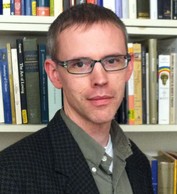STILLPOINT Archive: last updated 05/09/2016
by Dr. Chad P. Stutz | Department of English Language and Literature
Each year a small percentage of Gordon faculty are on sabbaticals, semester-long breaks from normal teaching and administrative responsibilities. This set-apart time—the word sabbatical is derived from the Hebrew shabbat—frees them for intensive research, writing or other scholarly work.
I am launching a new research project examining the life and works of the 19th-century Scottish adventure novelist R. M. Ballantyne (1825–1894), with the ultimate goal of producing a full-length critical biography of this once wildly popular but now largely forgotten writer. My interest in Ballantyne grew out of a senior seminar I taught a few years ago entitled Adventure, Nation, and Empire, which explored the tradition of British adventure fiction from Daniel Defoe through J. R. R. Tolkien. My teaching and research focus on British romanticism, Victorian literature and culture, and the intersection of Christianity and aesthetics in the 18th and 19th centuries, especially among English and American evangelicals. Since the only biography of Ballantyne was published in the late ’60s, the time is ripe for a reconsideration of this novelist whom Robert Louis Stevenson once admiringly referred to as “Ballantyne the Brave.”
The author of more than 90 works, Ballantyne is most famous for The Coral Island—a novel that almost a century later prompted William Golding to write Lord of the Flies. An evangelical Christian who took seriously his influence on a generation of young boys, Ballantyne helped to shape mid-Victorian notions of faith, masculinity, empire and race.
One of the most exciting parts of working on a critical biography is the chance to do archival research. I took two trips during my sabbatical this spring—to the Harry Ransom Center at the University of Texas and to Yale University, which hold some of Ballantyne’s papers and manuscripts. I am also planning future trips to UCLA, the National Library of Scotland in Edinburgh, and the Hudson’s Bay Company Archives in Manitoba, Canada, where Ballantyne spent several years working as a young man in the 1840s. Quite fittingly, my effort to follow the course of Ballantyne’s complex career has turned into an adventure all its own.
